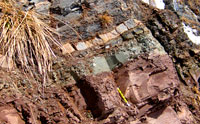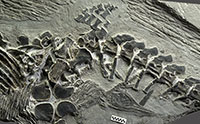Granite rocks exhibit mysterious black spheres, known as radiohalos. The only reasonable explanation for their origin is a recent, worldwide Flood. …read more Read more here: AIG Daily
Whale evolution depends on three fossil species. Claims about these being transitional to whales have now been shown to be bogus. …read more Read more here: creation.com
Why are so many Ice Age fossils found in strange climates? …read more Read more here: creation.com
Researchers recently published an article in Nature Geoscience highlighting findings from their analysis of a detrital zircon from Australia. BBC News has cited this mineral as the “oldest scrap of Earth crust”—is this conclusion accurate? More… …read more Read more here: icr.org
‘Early Cambrian’ arthropod fossils showing ‘exceptionally preserved eyes’ with ‘modern optics’ should be an eye-opener for evolutionists-but they resort to ‘spin’ instead …read more Read more here: creation.com
The tiny black flecks found in granite testify to a powerful and recent worldwide Flood. But you have to look closely. …read more Read more here: AIG Daily
New discoveries in northwestern India indicate lake Kotla Dahar retained more water in the past. When and how did the climate change? Does the history recorded in Genesis provide a useful context? More… …read more Read more here: icr.org
Rich new fossil bed promises to revolutionize evolutionary understanding of the Cambrian explosion. …read more Read more here: AIG Daily
A surprising rock discovery in West Virginia has red-flagged the uniformitarian analysis of sediment deposits previously thought to be non-marine in origin. More… …read more Read more here: icr.org
News headlines worldwide recently reported Europe’s oldest human footprint discovery. How old are the tracks? It appears the media and researchers answer this question by following the same misleading trends. More… …read more Read more here: icr.org
Bill Nye claimed sea-floor spreading shows long ages, but catastrophic plate tectonics and rapid reversals fit the data better and confirm the biblical account. …read more Read more here: AIG Daily
Over 50 years ago there was intense debate in the conventional scientific community on the origin and formation of granites. However, there are still some unresolved issues. …read more Read more here: AIG Daily
One of the latest ephemeral fossils comes from China—a baby ichthyosaur halfway in and halfway out of its mother’s body. Though fossilization tragically ended the baby’s transition from the womb, could this specimen support the story that a land reptile evolved into the first ichthyosaur? More… …read more Read more here: icr.org
It’s a lot younger than many people believe. …read more Read more here: creation.com
Bill Nye and other skeptics say the earth cannot be 6,000 years old as the Bible teaches because the ice cores took long ages to form. Michael Oard examines these claims. …read more Read more here: AIG Daily
Trace elements tell a tale of critically low oxygen that nearly turned out the lights on the evolution of complex life. …read more Read more here: AIG Daily
The pollen and spores from the Paleoproterozoic Roraima Formation in South America has often been cited by creationists as evidence against the evolutionary interpretation of the fossil record. It has, however, received little interest from the scientific community, having been ignored altogether since the 1970s. Although the discovery was published in Nature, there were no subsequent articles dealing with it. The consensus seems to be that the microfossils represent a case of contamination. In the original article in Nature an additional objection was raised: since the sediment containing the microfossils is described as thermally metamorphosed, the pollen and spores should [More]
Bill Nye mentioned ancient life in the fossil record as evidence of evolution—but it actually confirms the biblical Flood account. Get answers! …read more Read more here: AIG Daily
Discover why these geologists believe Lake Missoula flooded just once, rather than repeated flooding as Bill Nye asserted in the recent creation debate. …read more Read more here: AIG Daily
Despite debate about the accuracy of the uranium “clocks” they contain, scientists led by University of Wisconsin’s John Valley say they’ve found a zircon with a confirmed age of 4.4 billion years. …read more Read more here: AIG Daily
Did human feet in ancient time walk upon England’s river shore? …read more Read more here: AIG Daily
Sep 8, 2008 … A gecko foot encased in amber has been dubbed the oldest gecko fossil ever discovered, according to researchers from Oregon State University and the Natural History Museum in London.1 The amber deposits containing the remarkably well-preserved fossil, discovered in Myanmar, are said to be around 100 million years old, which would double the “date” of the earliest-known gecko, making it “43 to 56 million years older” than the prior record holder.2 The discovery has been given the customary evolutionary interpretation, but the evidence presented by this gecko foot actually fits much better within a biblical creation [More]
In the recent debate, Bill Nye frequently mentioned radiometric dating as evidence of an old earth—but he never addressed the major assumptions involved. Get answers! …read more Read more here: AIG Daily
Greenland’s Jakobshavn Isbr? glacier set a new speed record for glacial flow. The ice stream’s calculated average speed for summer 2012 was 46 meters per day—more than 6 feet per hour—the fastest recorded speed for any Antarctica or Greenland ice stream. More… …read more Read more here: icr.org
Complex biomolecules such as proteins are increasingly being found in fossils supposedly ‘millions of years old’. …read more Read more here: creation.com
Paleontologists recently presented their analysis of original skin leftovers from three marine reptile fossils and inadvertently revealed three clues that darken their evolutionary explanations. More… …read more Read more here: icr.org
A hand fit for a human was found surprisingly deep in the fossil record. …read more Read more here: AIG Daily

















![Bill & Gloria Gaither – John [Live] ft. Mountain Heart Bill & Gloria Gaither – John [Live] ft. Mountain Heart](http://img.youtube.com/vi/IBHwzljRV14/0.jpg)


























